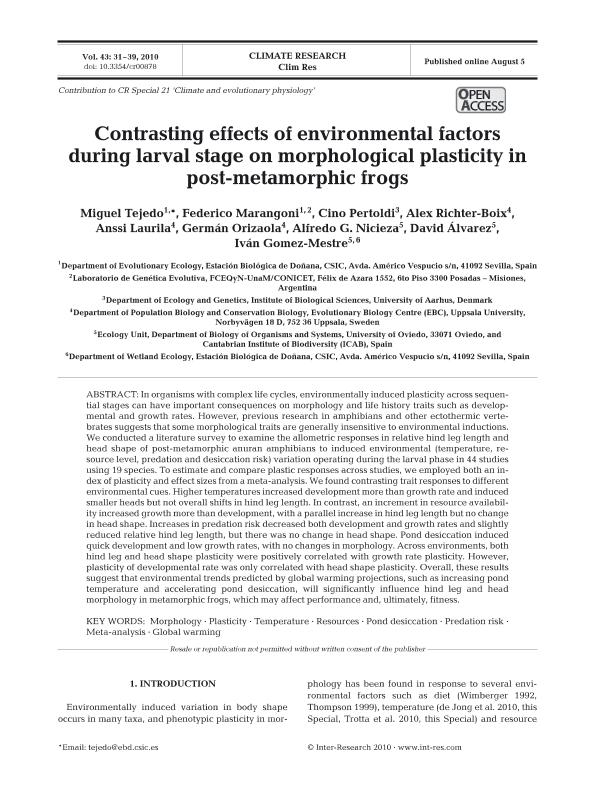Artículo
Contrasting effects of environmental factors during larval stage on morphological plasticity in post-metamorphic frogs
Tejedo, Miguel; Marangoni, Federico ; Pertoldi, Cino; Richter-Boix, Alex; Laurila, Anssi; Orizaola, Germán; Nicieza, Alfredo G.; Álvarez, David; Gomez Mestre, Iván
; Pertoldi, Cino; Richter-Boix, Alex; Laurila, Anssi; Orizaola, Germán; Nicieza, Alfredo G.; Álvarez, David; Gomez Mestre, Iván
 ; Pertoldi, Cino; Richter-Boix, Alex; Laurila, Anssi; Orizaola, Germán; Nicieza, Alfredo G.; Álvarez, David; Gomez Mestre, Iván
; Pertoldi, Cino; Richter-Boix, Alex; Laurila, Anssi; Orizaola, Germán; Nicieza, Alfredo G.; Álvarez, David; Gomez Mestre, Iván
Fecha de publicación:
05/08/2010
Editorial:
Inter-Research
Revista:
Climate Research
ISSN:
0936-577X
Idioma:
Inglés
Tipo de recurso:
Artículo publicado
Clasificación temática:
Resumen
In organisms with complex life cycles, environmentally induced plasticity across sequential stages can have important consequences on morphology and life history traits such as developmental and growth rates. However, previous research in amphibians and other ectothermic vertebrates suggests that some morphological traits are generally insensitive to environmental inductions. We conducted a literature survey to examine the allometric responses in relative hind leg length and head shape of post-metamorphic anuran amphibians to induced environmental (temperature, resource level, predation and desiccation risk) variation operating during the larval phase in 44 studies using 19 species. To estimate and compare plastic responses across studies, we employed both an index of plasticity and effect sizes from a meta-analysis. We found contrasting trait responses to different environmental cues. Higher temperatures increased development more than growth rate and induced smaller heads but not overall shifts in hind leg length. In contrast, an increment in resource availability increased growth more than development, with a parallel increase in hind leg length but no change in head shape. Increases in predation risk decreased both development and growth rates and slightly reduced relative hind leg length, but there was no change in head shape. Pond desiccation induced quick development and low growth rates, with no changes in morphology. Across environments, both hind leg and head shape plasticity were positively correlated with growth rate plasticity. However, plasticity of developmental rate was only correlated with head shape plasticity. Overall, these results suggest that environmental trends predicted by global warming projections, such as increasing pond temperature and accelerating pond desiccation, will significantly influence hind leg and head morphology in metamorphic frogs, which may affect performance and, ultimately, fitness.
Archivos asociados
Licencia
Identificadores
Colecciones
Articulos(CCT - NORDESTE)
Articulos de CTRO.CIENTIFICO TECNOL.CONICET - NORDESTE
Articulos de CTRO.CIENTIFICO TECNOL.CONICET - NORDESTE
Citación
Tejedo, Miguel; Marangoni, Federico; Pertoldi, Cino; Richter-Boix, Alex; Laurila, Anssi; et al.; Contrasting effects of environmental factors during larval stage on morphological plasticity in post-metamorphic frogs; Inter-Research; Climate Research; 43; 1-2; 5-8-2010; 31-39
Compartir
Altmétricas



